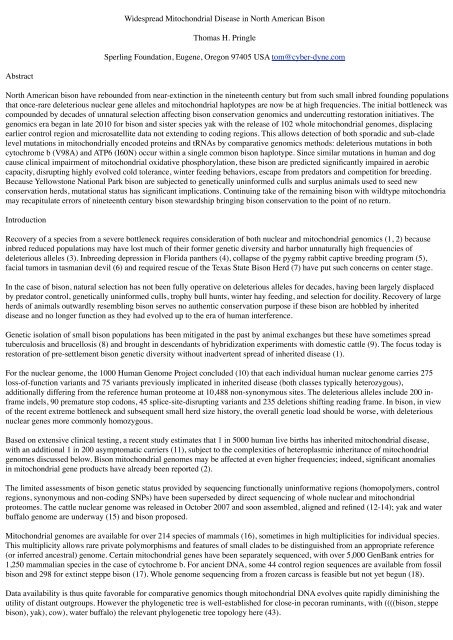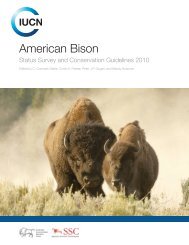Declaration Dr. Thomas H. Pringle - Buffalo Field Campaign
Declaration Dr. Thomas H. Pringle - Buffalo Field Campaign
Declaration Dr. Thomas H. Pringle - Buffalo Field Campaign
You also want an ePaper? Increase the reach of your titles
YUMPU automatically turns print PDFs into web optimized ePapers that Google loves.
Abstract<br />
Widespread Mitochondrial Disease in North American Bison<br />
<strong>Thomas</strong> H. <strong>Pringle</strong><br />
Sperling Foundation, Eugene, Oregon 97405 USA tom@cyber-dyne.com<br />
North American bison have rebounded from near-extinction in the nineteenth century but from such small inbred founding populations<br />
that once-rare deleterious nuclear gene alleles and mitochondrial haplotypes are now be at high frequencies. The initial bottleneck was<br />
compounded by decades of unnatural selection affecting bison conservation genomics and undercutting restoration initiatives. The<br />
genomics era began in late 2010 for bison and sister species yak with the release of 102 whole mitochondrial genomes, displacing<br />
earlier control region and microsatellite data not extending to coding regions. This allows detection of both sporadic and sub-clade<br />
level mutations in mitochondrially encoded proteins and tRNAs by comparative genomics methods: deleterious mutations in both<br />
cytochrome b (V98A) and ATP6 (I60N) occur within a single common bison haplotype. Since similar mutations in human and dog<br />
cause clinical impairment of mitochondrial oxidative phosphorylation, these bison are predicted significantly impaired in aerobic<br />
capacity, disrupting highly evolved cold tolerance, winter feeding behaviors, escape from predators and competition for breeding.<br />
Because Yellowstone National Park bison are subjected to genetically uninformed culls and surplus animals used to seed new<br />
conservation herds, mutational status has significant implications. Continuing take of the remaining bison with wildtype mitochondria<br />
may recapitulate errors of nineteenth century bison stewardship bringing bison conservation to the point of no return.<br />
Introduction<br />
Recovery of a species from a severe bottleneck requires consideration of both nuclear and mitochondrial genomics (1, 2) because<br />
inbred reduced populations may have lost much of their former genetic diversity and harbor unnaturally high frequencies of<br />
deleterious alleles (3). Inbreeding depression in Florida panthers (4), collapse of the pygmy rabbit captive breeding program (5),<br />
facial tumors in tasmanian devil (6) and required rescue of the Texas State Bison Herd (7) have put such concerns on center stage.<br />
In the case of bison, natural selection has not been fully operative on deleterious alleles for decades, having been largely displaced<br />
by predator control, genetically uninformed culls, trophy bull hunts, winter hay feeding, and selection for docility. Recovery of large<br />
herds of animals outwardly resembling bison serves no authentic conservation purpose if these bison are hobbled by inherited<br />
disease and no longer function as they had evolved up to the era of human interference.<br />
Genetic isolation of small bison populations has been mitigated in the past by animal exchanges but these have sometimes spread<br />
tuberculosis and brucellosis (8) and brought in descendants of hybridization experiments with domestic cattle (9). The focus today is<br />
restoration of pre-settlement bison genetic diversity without inadvertent spread of inherited disease (1).<br />
For the nuclear genome, the 1000 Human Genome Project concluded (10) that each individual human nuclear genome carries 275<br />
loss-of-function variants and 75 variants previously implicated in inherited disease (both classes typically heterozygous),<br />
additionally differing from the reference human proteome at 10,488 non-synonymous sites. The deleterious alleles include 200 inframe<br />
indels, 90 premature stop codons, 45 splice-site-disrupting variants and 235 deletions shifting reading frame. In bison, in view<br />
of the recent extreme bottleneck and subsequent small herd size history, the overall genetic load should be worse, with deleterious<br />
nuclear genes more commonly homozygous.<br />
Based on extensive clinical testing, a recent study estimates that 1 in 5000 human live births has inherited mitochondrial disease,<br />
with an additional 1 in 200 asymptomatic carriers (11), subject to the complexities of heteroplasmic inheritance of mitochondrial<br />
genomes discussed below. Bison mitochondrial genomes may be affected at even higher frequencies; indeed, significant anomalies<br />
in mitochondrial gene products have already been reported (2).<br />
The limited assessments of bison genetic status provided by sequencing functionally uninformative regions (homopolymers, control<br />
regions, synonymous and non-coding SNPs) have been superseded by direct sequencing of whole nuclear and mitochondrial<br />
proteomes. The cattle nuclear genome was released in October 2007 and soon assembled, aligned and refined (12-14); yak and water<br />
buffalo genome are underway (15) and bison proposed.<br />
Mitochondrial genomes are available for over 214 species of mammals (16), sometimes in high multiplicities for individual species.<br />
This multiplicity allows rare private polymorphisms and features of small clades to be distinguished from an appropriate reference<br />
(or inferred ancestral) genome. Certain mitochondrial genes have been separately sequenced, with over 5,000 GenBank entries for<br />
1,250 mammalian species in the case of cytochrome b. For ancient DNA, some 44 control region sequences are available from fossil<br />
bison and 298 for extinct steppe bison (17). Whole genome sequencing from a frozen carcass is feasible but not yet begun (18).<br />
Data availability is thus quite favorable for comparative genomics though mitochondrial DNA evolves quite rapidly diminishing the<br />
utility of distant outgroups. However the phylogenetic tree is well-established for close-in pecoran ruminants, with ((((bison, steppe<br />
bison), yak), cow), water buffalo) the relevant phylogenetic tree topology here (43).










